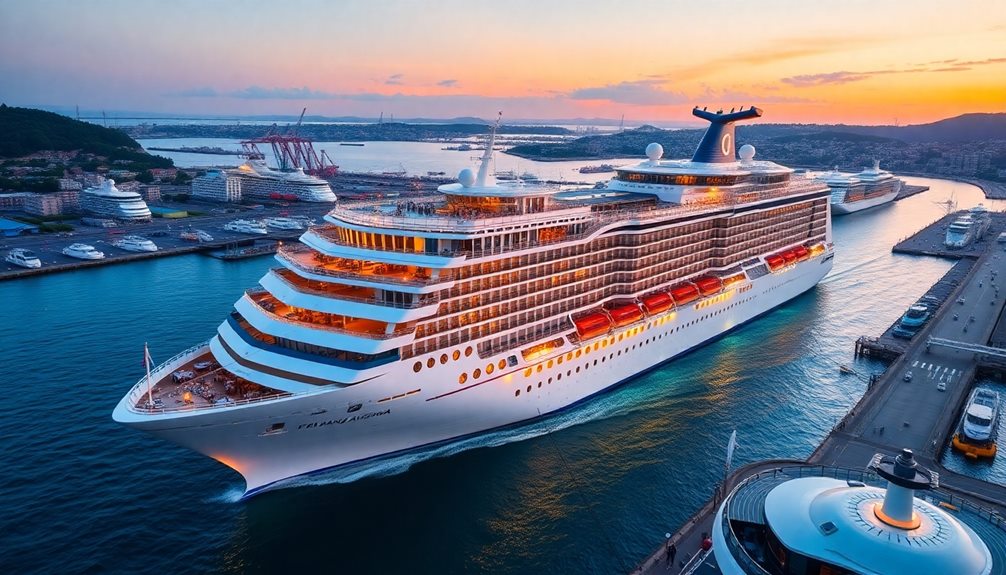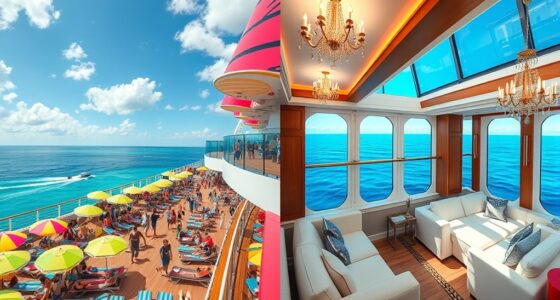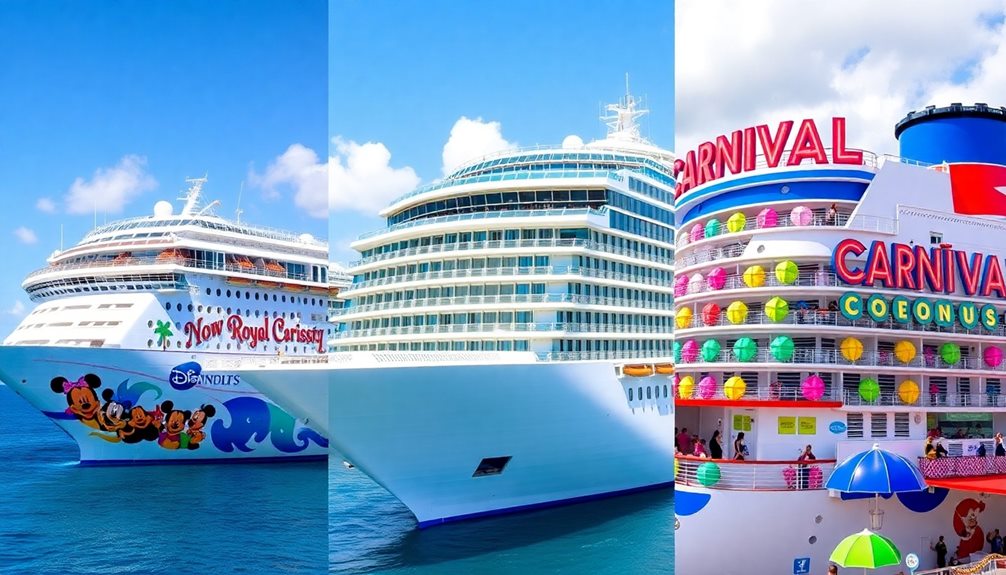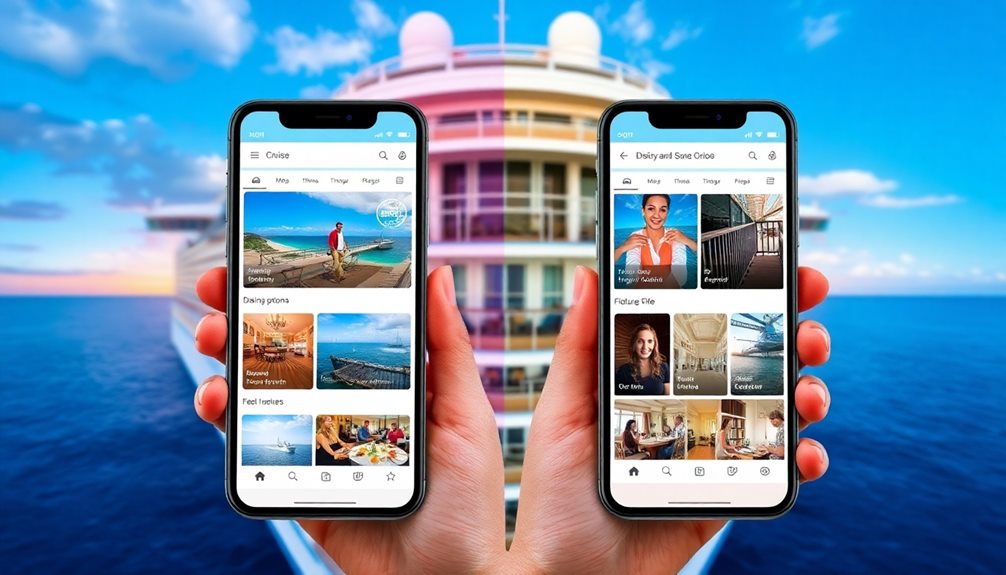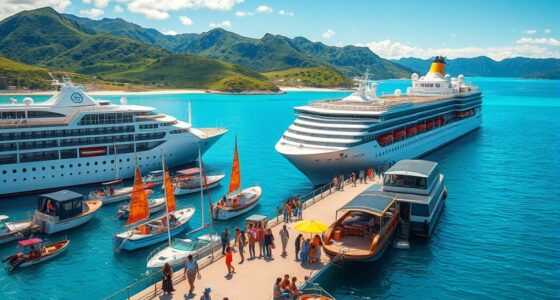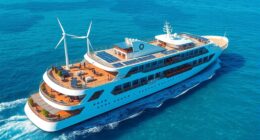When you compare premium cruise lines like Celebrity, Princess, and Holland America, you notice they each offer unique experiences. Celebrity focuses on modern luxury with exceptional dining and entertainment. Princess stands out with its lively ships and extensive family-friendly programs. Holland America appeals to a more mature crowd, emphasizing personalized service and cultural enrichment. Each line has different pricing packages that can enhance your experience, from all-inclusive options to flexible fare choices. You'll even find varied dining experiences and activities tailored to different tastes. Keep exploring to uncover more about what each line has in store for your next cruise.
Key Takeaways
- Dining Experience: Celebrity focuses on upscale dining, Holland America emphasizes fresh seafood, and Princess offers a wide variety of flexible dining options.
- Service Quality: Holland America is renowned for personalized service, while Princess provides attentive service, and Celebrity may lack a personal touch.
- Entertainment Offerings: Celebrity features Las Vegas-style shows, Holland America has diverse live music options, and Princess showcases Broadway-quality productions and original musicals.
- Pricing Packages: Celebrity offers All Included and AquaClass Rates, Holland America provides Base Fare and Have It All Package, while Princess has Base Fare, Princess Plus, and Princess Premier.
- Target Demographics: Celebrity appeals to modern luxury travelers, Holland America targets mature audiences, and Princess is family-friendly with extensive kids programs.
Overview of Premium Cruise Lines
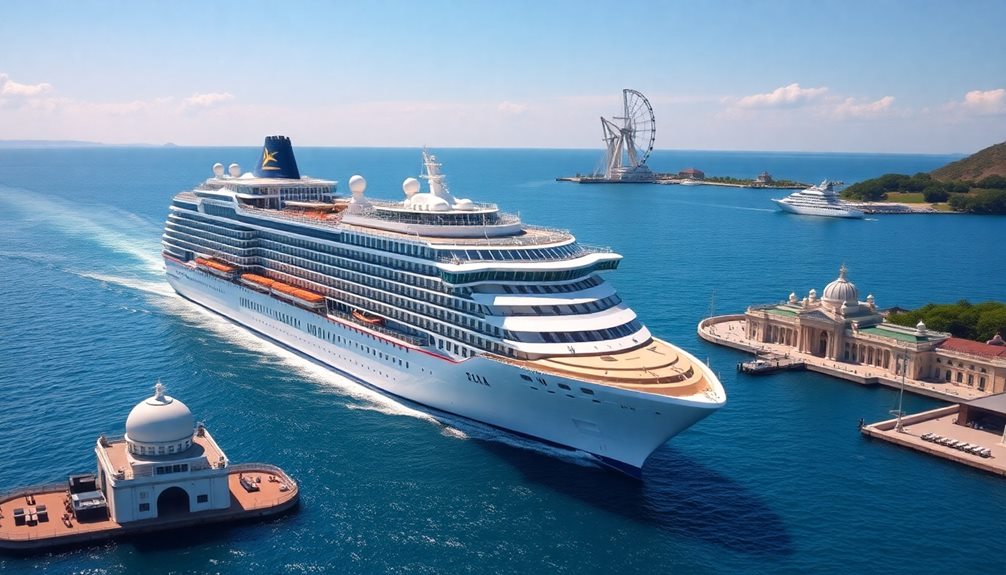
When you think about premium cruise lines, you'll find a diverse array of options that cater to different tastes and preferences.
Celebrity Cruises stands out with its modern luxury approach, attracting a varied clientele who appreciate high-quality dining options, excellent service, and a relaxed atmosphere aboard mid-size to large ships like the Millennium and Edge classes.
If you're looking for a more traditional cruising experience, Holland America might be your choice. They target a mature demographic, often aged 60 and above, and are known for exceptional service and cuisine on smaller to mid-size ships.
On the other hand, Princess Cruises offers larger ships that appeal to couples and families alike. They provide a lively onboard atmosphere and diverse dining options to suit various palates.
Each of these premium cruise lines delivers unique onboard attractions and entertainment. With Celebrity focusing on engaging shows and activities, Holland America emphasizing cultural music and enrichment programs, and Princess showcasing Broadway-quality productions, you're bound to find an experience that suits your preferences.
Celebrity Cruises Pricing Packages
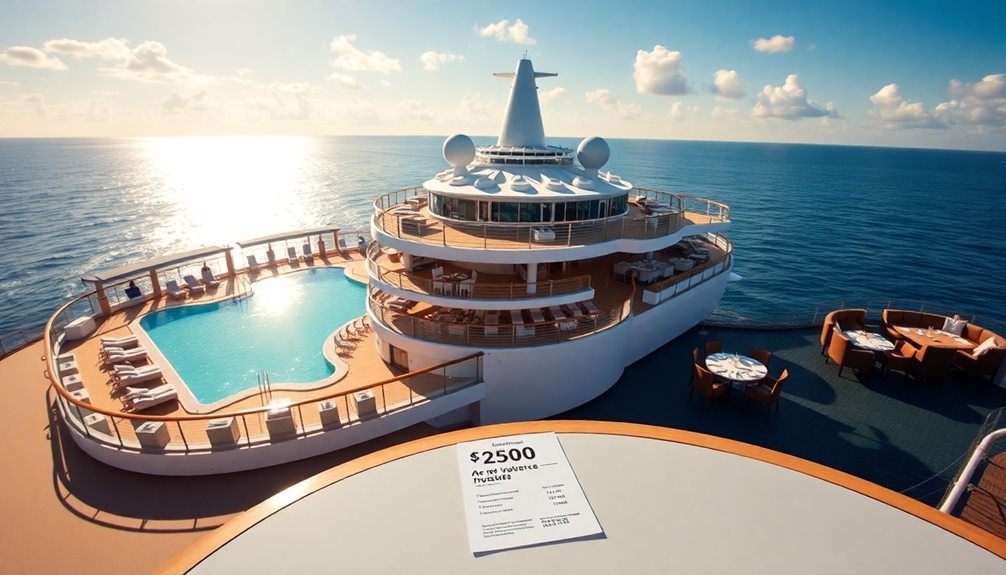
Celebrity Cruises offers a range of pricing packages designed to fit different preferences and budgets. Their options include Cruise-Only Rates, All Included packages, and AquaClass Rates, each catering to various needs.
The All Included packages provide significant savings of $200-800, bundling Classic Drinks and basic Wi-Fi for a seamless experience.
If you're after enhanced wellness experiences, AquaClass Rates grant you exclusive access to the Blu restaurant, the Sea Thermal Suite, and fitness classes, along with discounted spa packages. This is perfect for those who prioritize relaxation and health during their cruise.
For the ultimate luxury experience, consider The Retreat, which features the Luminae restaurant, an exclusive lounge, and a sundeck.
You'll enjoy personalized assistance with a concierge service and a personal butler, ensuring your every need is met. The Butler Chat service allows you to communicate with your butler directly via your personal devices, making reservations and assistance easy and convenient.
With Celebrity Cruises, you'll find that their pricing packages cater not only to your budget but also to your desire for a premium cruise experience.
Holland America Line Fare Options
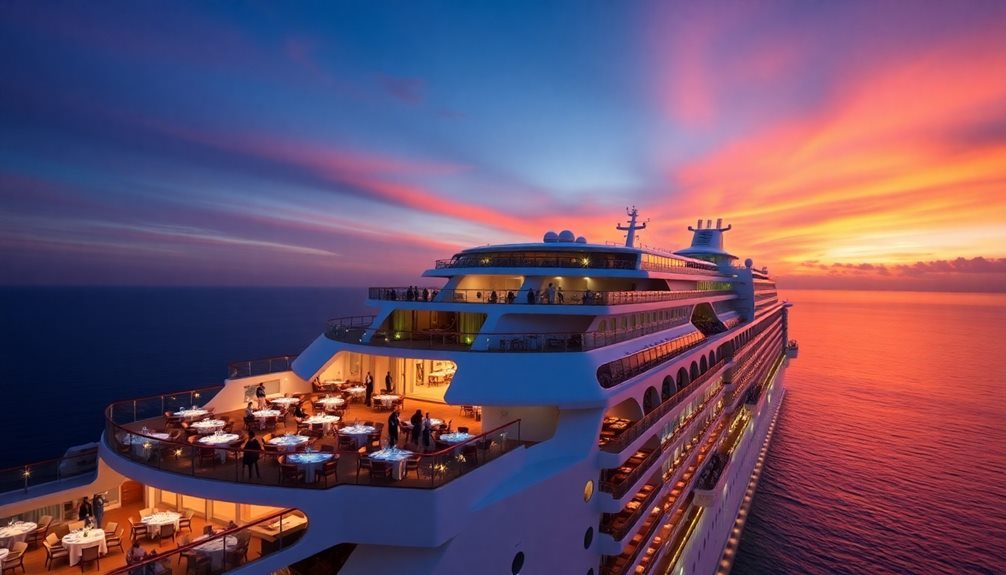
When considering Holland America Line, you'll find two main fare options to choose from.
The Base Fare gives you the flexibility to pick your own amenities, while the Have It All Package bundles popular perks like shore excursion credits and dining options.
Understanding these choices can help you tailor your cruise experience to fit your needs.
Base Fare Structure
Holland America Line offers a straightforward Base Fare pricing option, letting you choose standard cruise rates without any added perks. This approach gives you the freedom to customize your experience based on your preferences.
Here are three key features of the Base Fare structure:
- Standard Rates: You'll enjoy the basics of cruising without the extras, perfect if you're looking to keep costs down.
- Dining Options: While the base fare doesn't include specialty dining, you can opt for various dining experiences onboard to suit your tastes.
- Customization: You can enhance your cruise with add-ons like the Club Orange for priority services or choose specific itineraries for shore excursions.
While the Base Fare provides a solid foundation, Holland America also offers the Have It All Package for those wanting more. This package includes a shore excursion credit, a beverage package, and specialty dining options, elevating your cruise experience.
If you're ready to explore Holland America's premium lines, consider how the base fare can fit your travel style while allowing for optional enhancements.
Have It All Package
Wondering how to elevate your cruising experience? The "Have It All" package from Holland America Line is the perfect solution. This all-inclusive option combines multiple amenities, delivering exceptional value for your trip.
Here's a quick look at what the "Have It All" package includes:
| Feature | Description |
|---|---|
| Shore Excursion Credit | $100 to $300 credit for guided tours and activities in port destinations. |
| Specialty Dining Options | Enjoy dining at select restaurants for one to three nights during your voyage. |
| Signature Beverage Package | Access to a variety of wines, beers, spirits, cocktails, and non-alcoholic drinks throughout the cruise. |
| Wi-Fi Surf Package | Stay connected at sea with internet access included. |
With the "Have It All" package, you get a thorough cruising experience that enhances your overall amenities. Whether you're sipping cocktails or exploring new ports, you'll appreciate the bundled value this premium line offers. Make your Holland America Line cruise unforgettable with this fantastic package!
Princess Cruises Fare Enhancements
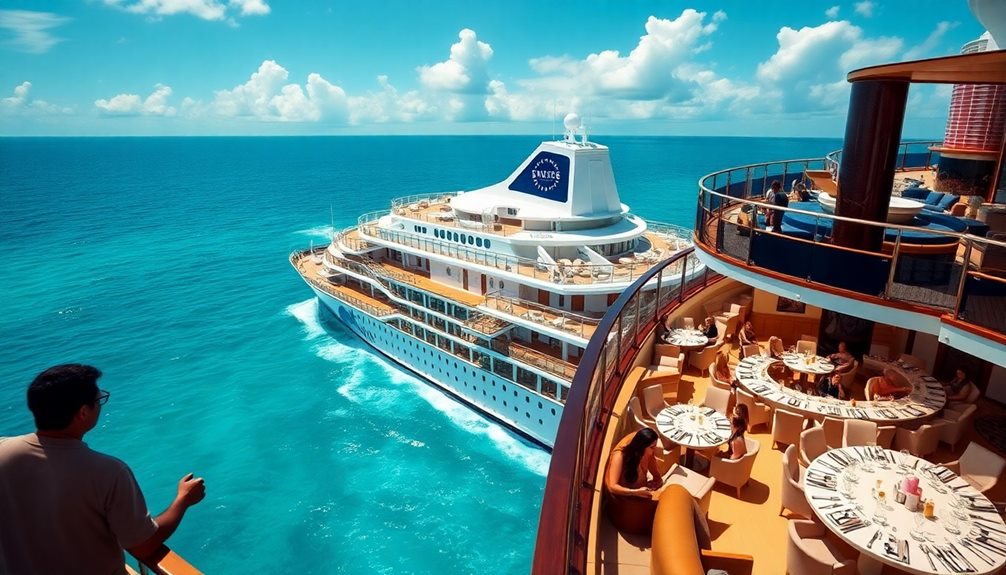
When you choose Princess Cruises, you'll find a variety of pricing packages designed to enhance your experience.
The Princess Plus and Princess Premier packages offer exclusive amenities like Wi-Fi, premium drinks, and specialty dining, making your cruise even more enjoyable.
Plus, with the upcoming Sanctuary Collection, you'll have access to luxurious spaces that elevate your getaway.
Pricing Packages Overview
Princess Cruises offers a range of pricing packages that cater to different preferences and budgets, ensuring you can tailor your cruise experience.
Here's a quick look at what you can choose from:
- Base Fare: Standard pricing without additional perks for those who want to customize their experience.
- Princess Plus: For $60 per day, this package includes Wi-Fi for one device, non-alcoholic drinks, gratuities, casual meals, fitness classes, desserts, and convenient OceanNow Service for onboard delivery.
- Princess Premier: At $80 per day, you get Wi-Fi for up to four devices, premium drinks, unlimited meals and desserts, specialty dining options, and professional photos.
Additionally, look forward to the Sanctuary Collection, launching in late 2024, which will provide exclusive access to a sun deck, private restaurant, and Suite Lounge.
These pricing packages allow you to elevate your cruise experience, whether you want the essentials or luxurious amenities.
With Princess Cruises, you can enjoy the comfort and flexibility that suits your vacation style.
Exclusive Amenities Offered
Choosing the right pricing package with Princess Cruises not only tailors your cruise experience but also opens the door to exclusive amenities that enhance your journey.
With the Princess Plus Package, you can enjoy Wi-Fi for one device, non-alcoholic drinks, gratuities, and even the convenience of OceanNow Service, allowing you to order meals and drinks directly to your location on the ship.
If you're looking for even more perks, the Princess Premier Package offers Wi-Fi for up to four devices, premium drinks, unlimited meals, and access to specialty dining options that showcase unique culinary concepts.
For those seeking elevated amenities, the Sanctuary Collection, launching in late 2024, will grant you access to the exclusive Sanctuary Club sun deck, a private restaurant, and a Suite Lounge.
Whether you choose the Princess Plus or Premier Package, you'll discover a world of exclusive amenities designed to make your cruise unforgettable.
Specialty dining options are available, ranging from casual bites to exquisite meals, ensuring there's something to satisfy every palate.
Enjoy your voyage with these enhancements and make the most of your Princess experience!
Comparing Dining Experiences
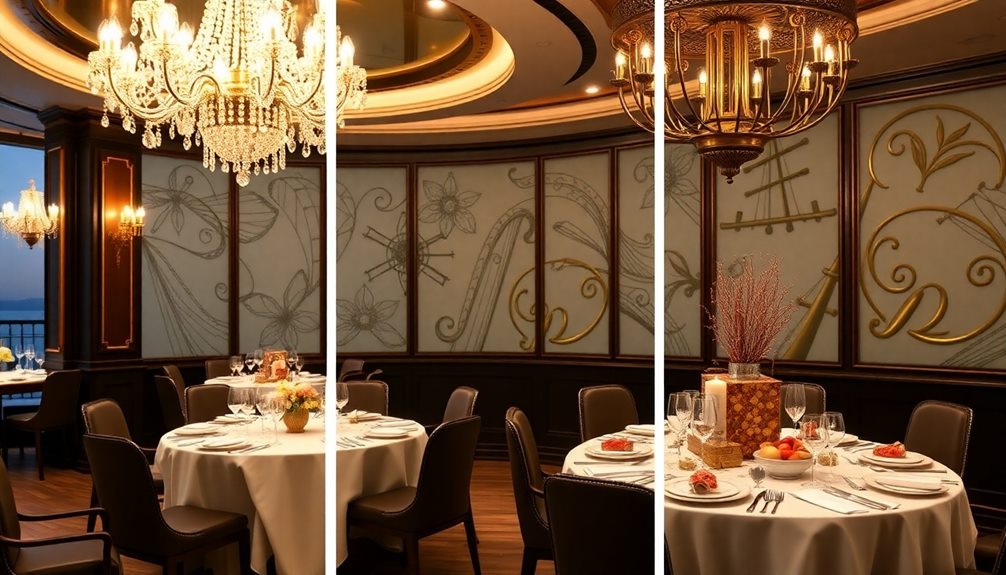
Dining aboard a cruise ship can considerably enhance your overall vacation experience, and each line offers unique culinary delights. Here are three key factors to evaluate when comparing dining experiences:
1. Diverse Dining Options: Celebrity Cruises impresses with upscale specialty restaurants and excellent service in the main dining room.
Holland America provides a robust culinary experience with its Global Fresh Fish program, while Princess Cruises excels with its Personalized Dining concept, catering to your preferences.
2. Complimentary Dining: Both Holland America and Princess Cruises offer complimentary dining, but Princess stands out for its extensive variety of dining venues, ensuring something for everyone.
3. Food Presentation and Quality: Celebrity is known for its exceptional food presentation, making meals a visual treat.
Holland America is praised for superior breakfast and lunch offerings, while Princess's specialty restaurants range from $15 to $149, ensuring a memorable culinary experience.
With flexible open-seating options, you can enjoy your meals at your own pace on Holland America, while Princess offers a customizable experience.
No matter your choice, you're in for a delightful dining journey at sea.
Entertainment and Activities Offered
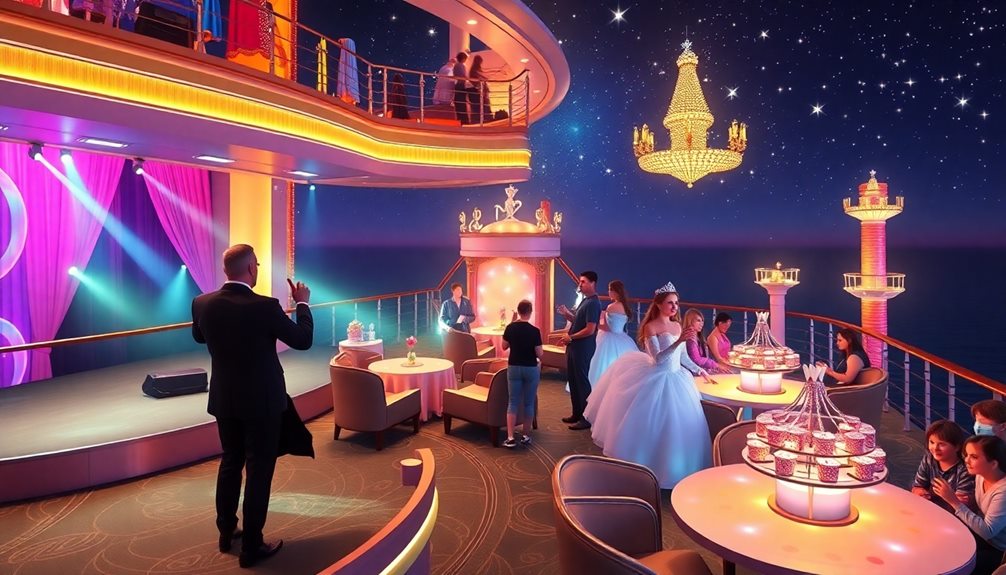
After savoring the diverse dining experiences each cruise line offers, it's time to explore the exciting entertainment and activities that await you onboard. Each line brings its unique flair to the table, ensuring you'll find something that captivates you.
Celebrity Cruises entices with a variety of entertainment options, from Las Vegas-style production shows to live music performances. You'll discover engaging activities like dance classes and meditation sessions, appealing to all age groups.
Holland America stands out with its Music Walk on Pinnacle Class ships, where live music spans various genres. You can also partake in enrichment-focused activities, including cooking and dancing lessons, perfect for mature travelers.
Princess Cruises offers vibrant evening entertainment with Broadway-quality productions, original musicals, and live music, all enhancing the atmosphere. During the day, you can join in on activities like art auctions and pickleball, while newer ships feature attractions like the Sea Breeze Rollglider.
All three lines promote family-friendly programs, allowing for multigenerational bonding, with Princess offering extensive kids programs and educational content from Discovery and Animal Planet. You'll never run out of things to do on these premium cruises!
Service Quality Across Lines
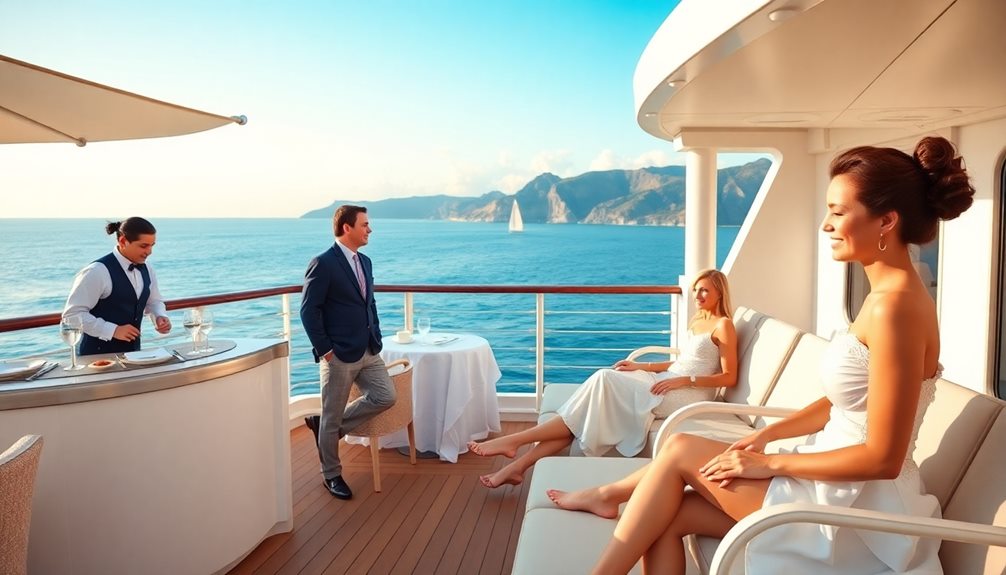
When it comes to service quality, each cruise line offers a distinct approach that enhances your onboard experience. Holland America, for instance, is renowned for its exceptional service quality with a strong focus on personalized attention, particularly during the dining experience. Many guests appreciate the attire recommendations that complement their dining experiences.
Princess Cruises provides attentive service that creates a lively atmosphere, appealing to a broader age demographic. Celebrity Cruises is known for its high-quality food but sometimes lacks the personal touch that enhances guest satisfaction.
Holland America consistently receives praise for its dining experience, especially in breakfast service and special dietary accommodations. This attention to detail results in higher guest approval.
While Princess Cruises provides friendly and lively service, it may not match the personalized service levels of Holland America.
Celebrity, known for its excellent cuisine, might leave you wanting more regarding that personal connection.
Cabin and Suite Comparisons
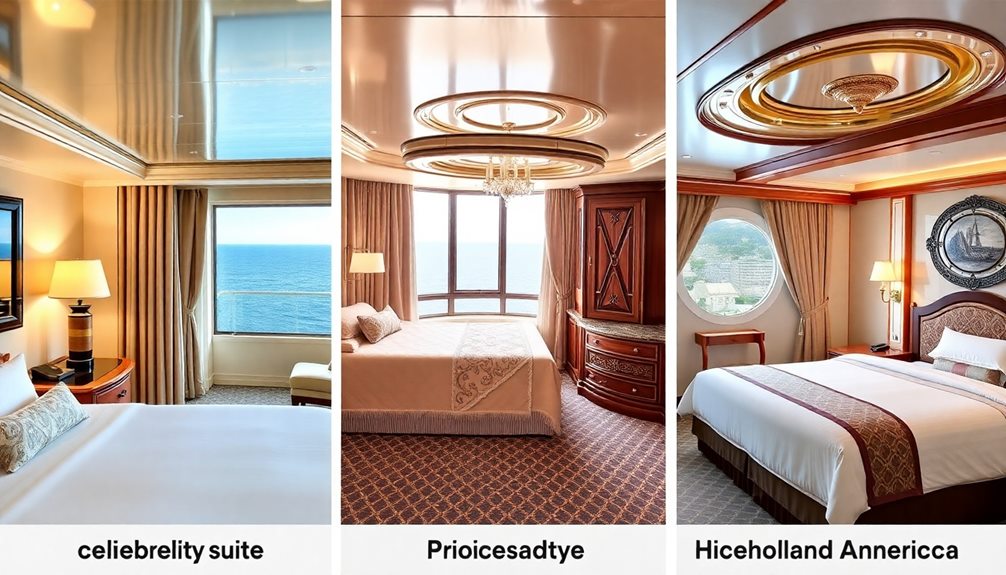
Cruisers often find themselves comparing cabin options, as each line presents unique offerings that cater to various preferences. Holland America boasts a range of cabin types, from windowless inside cabins to spacious suites that can reach 1,290 square feet.
Their Pinnacle Class ships feature well-designed bathrooms with glass-enclosed showers, adding a touch of luxury and an inviting atmosphere to your bathing experience. Additionally, modern fixtures in these bathrooms can enhance water efficiency, aligning with water efficiency trends in contemporary design.
On the other hand, Princess Cruises offers standard inside cabins ranging from 158 to 162 square feet and a variety of balcony cabins between 214 and 222 square feet. Their Mini-Suites and the expansive Sky Suite, at 1,873 square feet, are perfect for those seeking extra comfort.
For a modern aesthetic, Celebrity Cruises stands out with innovative cabin types like Infinite Veranda and traditional balconies, ensuring high-quality accommodations.
Both Holland America and Princess provide limited solo cabin options, making them more accessible for solo travelers. Princess's Sanctuary Collection enhances the experience with larger showers and new amenities on the Sun Princess.
Ultimately, your choice may depend on your accommodation preferences, whether you desire expansive suites or cozy standard inside cabins across these premier cruise lines.
Future Trends in Premium Cruising
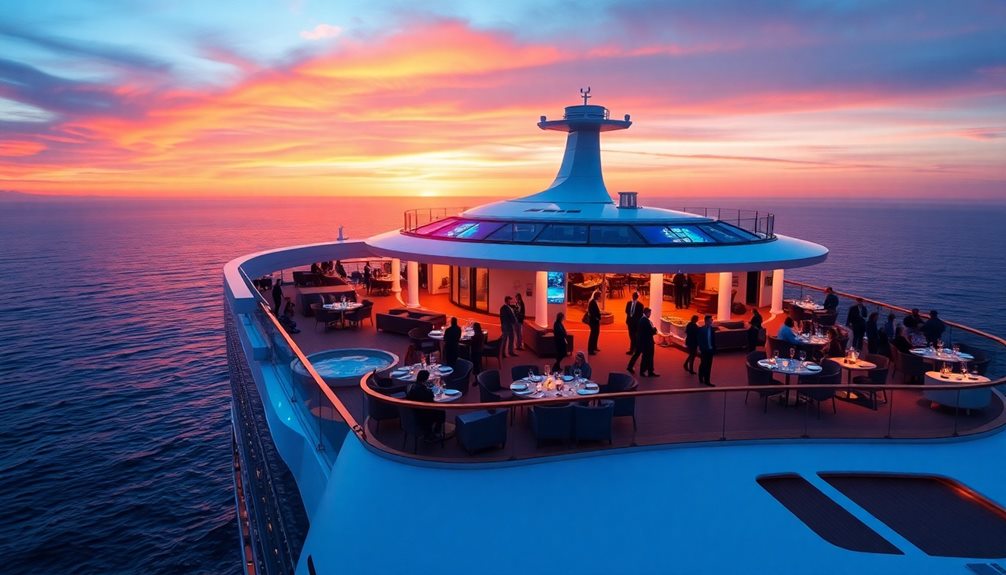
As you explore the various accommodations across premium cruise lines, it's clear that the industry is evolving rapidly to meet changing consumer demands.
Here are three trends shaping the future of premium cruising:
- Tiered Pricing Models: Premium cruise lines are adopting these models, allowing you to customize your cruise experience with packages tailored to your preferences and budget.
- Technology Integration: With advancements in technology, you can now use personal devices for service requests, reservations, and seamless communication with onboard staff.
- Exclusive Access Offerings: Lines like Princess Cruises are introducing unique onboard experiences, such as the Sanctuary Collection, that elevate premium experiences for guests seeking tranquility and luxury.
As competition intensifies among premium cruise lines, enhanced guest experiences are a priority.
Services like butler chat on Celebrity Cruises and priority dining options on Holland America's Club Orange package exemplify the shift towards personalized services.
The emphasis on unique onboard experiences and exclusive access will help these brands differentiate themselves in a crowded market, ensuring your cruise isn't just a trip, but a memorable journey tailored to your desires.
Conclusion
In choosing between Celebrity, Holland America, and Princess, remember that each line offers unique perks tailored to different preferences. Notably, a survey found that 70% of cruisers prioritize dining experiences when selecting a cruise line, highlighting the importance of culinary offerings in your decision-making process. By focusing on what matters most to you—be it food, entertainment, or service—you can guarantee your next premium cruise is memorable and perfectly suited to your tastes.

